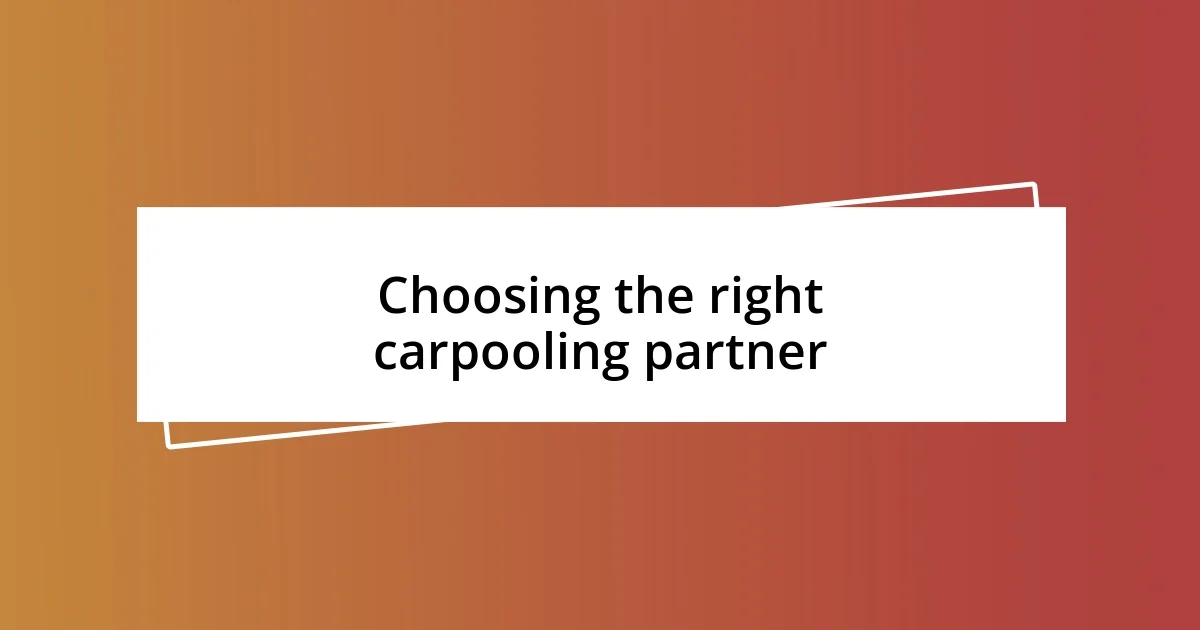Key takeaways:
- Carpooling fosters social connections, reduces costs, and contributes to environmental sustainability.
- Choosing compatible carpool partners improves reliability, communication, and overall ride enjoyment.
- Establishing clear agreements and safety protocols enhances the carpool experience and builds trust among participants.

Understanding carpooling benefits
One of the major benefits of carpooling that I’ve personally experienced is the sheer joy of connection. On a particularly long commute, I shared rides with colleagues, and those conversations transformed otherwise dull travel time into a social hour. It made me wonder—how often do we overlook opportunities to connect with others simply because we choose to drive alone?
Cost savings can’t be ignored either. I remember a time when gas prices shot up, and my budget was feeling the squeeze. By carpooling, I not only split the fuel costs but also discovered that sharing expenses fostered a sense of camaraderie. Isn’t it fascinating how saving money can also bring people closer together?
There’s something refreshing about reducing our carbon footprint as well. I was once part of a carpool initiative focused on sustainability, and knowing we were contributing to a cleaner environment gave our rides a purpose. Have you ever thought about how little changes in our daily routines can ripple out to make a bigger impact?

Choosing the right carpooling partner
Choosing the right carpooling partner can significantly enhance your commuting experience. I’ve learned that aligning schedules is crucial; nothing’s more frustrating than waiting for a partner who is consistently late. In my own experience, I found that commuting with someone whose rhythm matched mine fostered a sense of reliability. Have you ever waited endlessly while checking your watch, feeling your day slipping away?
Compatibility in communication styles also stands out. I’ve shared rides with people who preferred silence, while others thrived on conversation. It made a world of difference when I identified these preferences upfront. Establishing understandings, like agreed-upon music or talk time, can lead to a much more enjoyable ride.
Lastly, consider personal values and habits. I once partnered with someone who had a habit of snacking in the car, which I found distracting. Meanwhile, another partner was conscientious about keeping the space clean, which improved our overall atmosphere. When you identify these nuances, your shared time can become not just functional, but truly enjoyable.
| Aspect | Considerations |
|---|---|
| Schedule Compatibility | Partner’s punctuality and routine alignment. |
| Communication Style | Preference for quiet versus conversation during rides. |
| Personal Values | Respect for cleanliness, noise levels, and shared responsibilities. |

Setting clear carpooling agreements
Setting clear agreements for carpooling can make a significant difference in the overall experience. From my perspective, discussing expectations upfront saves everyone a lot of potential stress later. For instance, I recall a time when we didn’t clarify pick-up times, resulting in several awkward moments of miscommunication. By simply designating a specific start time and confirming it regularly, we not only reduced confusion but also established a rhythm that became our norm.
Here are some key points to consider when setting agreements:
- Pick-Up and Drop-Off Locations: Clearly define where everyone will be picked up and dropped off to avoid any surprises.
- Scheduled Days: Establish which days each participant will carpool to ensure everyone is on the same page.
- Costs: Agree on how expenses, like gas and tolls, will be shared for transparency and fairness.
- Riding Rules: Discuss preferences, such as music choices or conversation levels, to foster a comfortable atmosphere.
- Communication: Set guidelines on how to inform one another about delays or changes in schedule; it truly helps maintain trust and respect.
In my experience, having these agreements in place not only eliminates misunderstandings but also creates a sense of commitment among the participants. I once learned this the hard way—after a couple of miscommunications with a carpool buddy, we clarified our expectations, and the difference was night and day. It’s like having a shared playbook; everyone knows what to expect, making the rides smoother and more enjoyable.

Effective communication strategies
Effective communication in carpooling isn’t just about exchanging information; it’s about establishing a rapport that enhances the entire experience. I once traveled with someone who would send a quick message if they were running late, which transformed potential frustration into understanding. Have you ever found yourself stuck, wondering where your ride is? Just a simple text can ease those worries and keep everyone in the loop.
Additionally, I’ve discovered that being proactive in discussions really helps. Early on in one of my carpools, we decided to have a “weekly check-in” to talk about any concerns. This proactive approach allowed us to address minor issues before they escalated into bigger problems. It’s amazing how a few minutes each week can not only clarify expectations but also strengthen the bond between carpool partners.
Lastly, active listening plays a crucial role in effective communication. I remember a time when a carpool mate opened up about their stressful work week. Rather than just nodding along, I engaged with their feelings, which changed the atmosphere of our ride. Don’t you think creating a space where everyone feels heard makes the journey not just about getting from point A to point B, but about building a community? It’s these little moments of connection that genuinely enrich the carpool experience.

Managing schedules efficiently
Having a clear schedule is crucial for successful carpooling. I remember a particular week when we had multiple events scattered throughout our usual ride times. I took it upon myself to create a shared calendar where everyone could input their commitments. This simple act turned chaotic mornings into streamlined ones—everyone knew when to expect each other, which fostered an air of reliability that we all appreciated. How many times have you found yourself waiting, unsure if you were in the right place at the right time?
When it comes to sharing responsibilities, flexibility is key. I had a phase when I found myself frequently needing a ride at odd hours. Instead of burdening a friend with constant schedule changes, we established a rotating responsibility where each person could update their availability. This not only accommodated my needs but also empowered everyone involved to voice their preferences, which is such a win-win! Have you ever felt an unspoken tension because someone was always accommodating while you realized you weren’t?
Lastly, a shared commitment to punctuality makes a world of difference. After a few instances of late arrivals, we collectively agreed on a “grace period.” This allowed us a buffer while simultaneously discouraging tardiness. I recall one morning when I was running behind, and instead of feeling rushed, I had peace of mind knowing that my carpool buddies wouldn’t be counting the minutes. Isn’t it reassuring to establish unspoken agreements that enhance mutual respect? By syncing our schedules effectively, we created an environment where everyone could thrive together.

Maintaining carpool safety practices
Maintaining safety in carpooling goes beyond just wearing seatbelts; it includes establishing ground rules that everyone agrees upon. For instance, during one of my earlier carpools, we had a heartfelt discussion about not using our phones while driving. I remember the relief I felt knowing we were all committed to prioritizing safety over distractions. Have you ever been in a car where the driver was constantly glancing at their phone? It really does change the atmosphere and raises anxiety levels.
It’s essential to ensure that everyone understands the importance of open communication about safety concerns. One time, I noticed that one of my carpool buddies seemed unusually quiet after we had picked up an unfamiliar passenger. I took a moment to check in with them, and we ended up creating a rule that everyone should voice any discomfort before we even start driving. This simple practice turned what could have been an awkward situation into a strengthened bond. Isn’t it interesting how having a space for honest discussions can cultivate trust?
Regularly reviewing safety protocols is another way to maintain a secure carpool environment. I recall a particular day when we decided to have a quick “safety refresher” during our commute; we reiterated our expectations and shared any new concerns. This opened up a dialogue that revealed insights I hadn’t considered, like the importance of keeping emergency contacts readily available. How often do we really pause to think about these things? Creating a culture of safety doesn’t have to feel heavy; it can be as straightforward and engaging as a collaborative chat while on the road.












